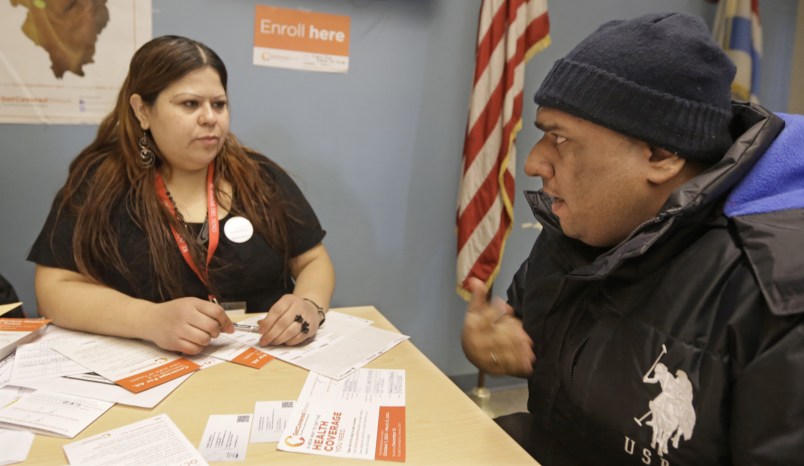With the recent closure of the initial enrollment period for the Affordable Care Act (ACA), there is enormous jockeying around interpreting the number of enrollees in state and federal exchanges. Proponents and opponents of the law are interpreting the preliminary numbers in the way that best makes their case. But what neither side is emphasizing enough is that enrollment in the ACA is far from over now that March 31st has passed. This is because millions of individuals will lose their insurance during 2014 – and Obamacare will be there to catch them.
An underappreciated fact about insurance status is that it is very dynamic. Every year, millions of Americans move into and out of insurance coverage. Since most people obtain coverage through an employer, the most common reason for losing coverage is a loss or change in jobs. But as anyone who has applied for COBRA coverage surely knows, the premium requirements to maintain generous employer coverage can be prohibitively expensive, particularly in the months when a job loss triggers a sharp income decline. Moreover, for Americans with any medical history who sought plans on the individual insurance market prior to the ACA, there were few affordable places to turn for protection against medical bankruptcy. In most states, insurers could deny coverage, or could charge sick individuals many multiples of their healthy counterparts to buy insurance.
The ACA’s state Marketplaces, in contrast, provide a non-discriminatory home for those losing their insurance coverage. In many cases, the loss of insurance coverage is what is known as a “qualifying event” that allows individuals to purchase insurance on their state Marketplace even after the open enrollment deadline. And for those seeing a sharp drop in income due to job loss, the tax credits available through the ACA exchanges can provide a much more affordable option than COBRA; in about half of the states, Medicaid will also be available for those suffering the largest income losses.
The number of Americans that will eligible for these qualifying events is large. In 2012, for example, 7.6 million people lost coverage and became uninsured. Almost half of this group, or 3.4 million, cited loss of job as the reason for losing insurance; another 600,000 cited loss of student insurance upon graduation or due to aging out of parental coverage; another 200,000 cited divorce as the source of insurance loss; while 60,000 lose insurance because they move. All of these are qualifying events that would trigger a special enrollment period for people who are currently insured but who lose access to coverage over the course of a year. These figures suggest that roughly 4 million Americans who previously faced the harsh reality of life without insurance can now access fairly priced and often subsidized insurance through state and federal exchanges, or, in many states, expanded Medicaid coverage.
This means that the numbers we will hear in the coming weeks about ACA enrollment are missing a critical component of enrollment that will arise during the year. The net effect on enrollment is hard to predict, given that some of those who lost jobs in early 2014 have already signed up, and given that others will gain insurance during the year and move off exchanges. But the increase in enrollment is likely to be sizable, so long as Americans understand that they may have an additional opportunity to enroll if they lose access to their current source of insurance.
But more important, this highlights why the ACA was so necessary in the U.S. in the first place. Our safety net was fundamentally broken, with millions of Americans at risk for slipping out of financial security if they lost coverage. The set of linked, non-discriminatory pathways to coverage created by the ACA has already resulted in over ten million people obtaining coverage during the open enrollment period. But now that open enrollment has concluded this same set of pathways will continue to provide a critical refuge for Americans seeking affordable coverage as their life circumstances change.
The importance of qualifying events also presents an enormous opportunity for advocates of the ACA to potentially enroll millions of newly eligible individuals into coverage. In particular, this population should be the focus of venue- and circumstance-based enrollment efforts, which target the places and times where transitions to uninsurance are most likely. When businesses close or there are mass layoffs for other reasons, it is important that the workers who are losing their jobs and their health insurance understand that a safety net option is available to them.
In particular, those losing their jobs may be exactly those who are suffering from the financial hardships that would make Medicaid or tax credits most important. Likewise, enrollment efforts over the next few months could focus on college graduations, where thousands of young adults may be losing their student coverage and need to know about other insurance options that are available. In short, advocates of the ACA should be both emphasizing the importance of this ongoing enrollment, and using all available tools to remind Americans that Obamacare is there for them as they go through these life transitions.
John Graves is an Assistant Professor at the Vanderbilt School of Medicine. Jonathan Gruber, widely considered the architect of what became the Affordable Care Act, is a Professor of Economics at MIT and a member of the Scholars Strategy Network.






